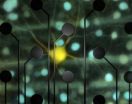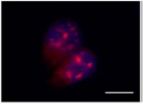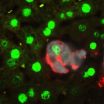(Press-News.org) New findings about the biological links between obesity, insulin resistance and type 2 diabetes may also shed light on the connection between obesity and cancer, says a scientist at The University of Texas at Dallas.
In a study published online June 5 in the journal Cell, UT Dallas' Dr. Jung-whan (Jay) Kim and colleagues at the University of California, San Diego found that a protein called HIF-1 alpha plays a key role in the development of insulin resistance and type 2 diabetes in obese mice.
The researchers genetically engineered mice to lack the HIF-1 alpha protein within the animals' fat cells, or adipocytes. The animals still made HIF-1 alpha in other types of cells and tissues in their bodies. Although the mice became obese when fed a high-fat diet, they did not develop insulin resistance and diabetes to near the extent that genetically normal, obese mice did.
"There is clearly a greater chance among the obese human population to develop insulin resistance and diabetes. We still don't know the exact mechanism, but now we know that HIF-1 alpha is very active in the pathogenesis of these diseases from obesity," said Kim, a co-lead author of the study who conducted the research while a postdoctoral researcher at UC San Diego and the Salk Institute for Biological Studies. He joined the UT Dallas faculty as an assistant professor of molecular and cell biology in 2013.
Kim said the findings about HIF-1, which stands for hypoxia inducible factor-1, are significant not only for their possible application to fighting insulin resistance and diabetes, but also cancer. Here's why:
Cells in the body normally consume oxygen to produce energy. But if oxygen levels decrease, for example during strenuous exercise or at high altitudes, cells enter a condition called hypoxia, or low oxygen. With oxygen in short supply, cells switch their metabolism. Instead of energy, the cells produce reactive oxygen species, which are molecules that can damage or kill cells. To help mitigate the damage, hypoxic cells activate HIF-1 alpha, which in turn shuts down the production of reactive oxygen species and signals inflammatory cells to migrate to the hypoxic areas.
"Organisms need to be able to temporarily adapt to the stress of hypoxic conditions until the situation changes, so when inflammatory cells see this kind of signal, they come to the hypoxic area to do their normal job, which is to basically eat damaged cells," Kim said.
In obesity, however, fat cells are in a chronic state of hypoxia.
"If you look at adipose, or fat tissue, in the obese, there is massive and chronic inflammation," he said. "It's a defense mechanism. The inflammatory cells are really good guys, but as obesity persists, inflammation becomes chronic.
"HIF-1 alpha is important for hypoxia adaptation, but it's constantly activated in the obese, and that's where it turns bad," Kim said. "In the obese, HIF-1 is aberrantly and chronically elevated and is the master regulator of ominous chronic inflammation."
To study the effect HIF-1 alpha might have on the development of insulin resistance and diabetes, Kim and his colleagues used genetic engineering techniques to completely remove, or "knock out" HIF-1 alpha from adipose tissue in obese mice.
"Once we knocked out HIF-1, everything got better," he said. "The fat cells survived and the mice remained obese, but we saw less inflammation in the fat tissue. These mice responded better to insulin than their normal counterparts, which means insulin sensitivity was improved and glucose tolerance was improved."
Kim said several pharmaceutical companies are developing HIF-1 alpha inhibitors to block the protein from functioning, which might one day result in medications to treat type 2 diabetes and insulin resistance in obese people. But the primary reason the pharmaceutical industry is already investigating HIF-1 alpha inhibitors is cancer.
"Tumor cells grow really fast, but the blood vessels that feed them oxygen cannot grow fast enough, so tumor cells become hypoxic," Kim explained. "The tumor cells have to develop some sort of mechanism to survive under hypoxic stress, and that's HIF-1 alpha.
"If you can inhibit HIF-1 alpha in a tumor cell, you can kill the cell, and that's why pharmaceutical companies are interested in HIF-1 inhibitors."
Kim said one motivation for the Cell study was to gain a better understanding of the links between obesity and cancer.
"There is a clear correlation between the two, but it's not clear why obese people have a greater chance of developing certain cancers," he said. "If you look at breast cancer, the glands that produce milk are completely surrounded by fat cells.
"Tumor tissue is hypoxic. Obese tissue is hypoxic. HIF-1 alpha is important in both conditions. I'm very motivated to study the interaction between breast cancer cells and fat cells."
INFORMATION:
The research published in Cell was funded by the National Institutes of Health, the American Diabetes Association and the Wellcome Trust.
Research helps clarify how obesity leads to type 2 diabetes, cancer
2014-06-05
ELSE PRESS RELEASES FROM THIS DATE:
New research explains how we use the GPS inside our brain to navigate
2014-06-05
The way we navigate from A to B is controlled by two brain regions which track the distance to our destination, according to new research funded by the Wellcome Trust and published in Current Biology.
The study found that at the beginning of a journey, one region of the brain calculates the straight-line to the destination ('the distance as a crow flies'), but during travel a different area of the brain computes the precise distance along the path to get there.
The findings pinpoint the precise brain regions used and in doing so change how scientists believed we use ...
Our own treacherous immune genes can cause cancer after viral infection
2014-06-05
HPV (human papillomavirus) infection is widely known to induce cancer. Many of the mutations that cause this virally-induced cancer are caused by a family of genes that normally combats viral infections, finds new UCL (University College London) research.
This raises the possibility of developing drugs to regulate the activity of these genes to prevent HPV-associated cancers from developing and reduce the ability of existing cancers to evolve resistance to treatments.
The research, published in Cell Reports, shows for the first time that genes from the 'APOBEC' family, ...
Cellular traffic control system mapped for the first time
2014-06-05
Cells must transport nutrients and messenger cargos through its membrane and transport them within the cell at the correct time and place. This procedure is complex and is regulated with the help of specific genes. If disturbances in the transport mechanism arise, severe diseases, such as diabetes, cancer and diverse neurological pathologies, are the consequence. The discovery of the molecular principles of cellular transport was honored with the Nobel Prize of physiology and medicine in 2013. While knowing the intracellular roads and the functioning of the cars that use ...
Unmasking viral invaders
2014-06-05
If you have it, you probably don't know it. Cytomegalovirus, or CMV, is perhaps one of the biggest pathogens you've never heard of—big, both proportionately and epidemiologically. It contains approximately 200 genes, compared to HIV's paltry 18, and it's everywhere. You can catch it as a preschooler salivating over blocks, or as a teenager experiencing your first kiss. Once you have it, you have it for life.
Good news: If you're healthy, it's harmless. Your T cells keep it in check, and you'll be none the wiser.
Bad news: If you have any medical condition that dampens ...
Making artificial vision look more natural
2014-06-05
In laboratory tests, researchers have used electrical stimulation of retinal cells to produce the same patterns of activity that occur when the retina sees a moving object. Although more work remains, this is a step toward restoring natural, high-fidelity vision to blind people, the researchers say. The work was funded in part by the National Institutes of Health.
Just 20 years ago, bionic vision was more a science fiction cliché than a realistic medical goal. But in the past few years, the first artificial vision technology has come on the market in the United States ...
Discovered a new way to control genetic material altered in cancer
2014-06-05
When we talk about genetic material, we are usually referring to the DNA (deoxyribonucleic acid) that we inherit from our parents. This DNA is the factory where is built a similar molecule called RNA (ribonucleic acid) which produces our proteins, such as hemoglobin or insulin , allowing the lives of our cells. But there is a special group called non-coding RNA that has a more enigmatic function.
The best known is microRNAs, tiny molecules that are responsible for turning on or off our genome like an electrical current switch. Today, an article published in the prestigious ...
A new model of liver regeneration
2014-06-05
Harvard Stem Cell Institute scientists at Boston Children's Hospital have new evidence in mice that it may be possible to repair a chronically diseased liver by forcing mature liver cells to revert back to a stem cell-like state.
The researchers, led by Fernando Camargo, PhD, happened upon this discovery while investigating whether a biochemical cascade called Hippo, which controls how big the liver grows, also affects cell fate. The unexpected answer, published in the journal Cell, is that switching off the Hippo-signaling pathway in mature liver cells generates very ...
Vanderbilt scientists discover that chemical element bromine is essential to human life
2014-06-05
Twenty-seven chemical elements are considered to be essential for human life.
Now there is a 28th – bromine.
In a paper published Thursday by the journal Cell, Vanderbilt University researchers establish for the first time that bromine, among the 92 naturally-occurring chemical elements in the universe, is the 28th element essential for tissue development in all animals, from primitive sea creatures to humans.
"Without bromine, there are no animals. That's the discovery," said Billy Hudson, Ph.D., the paper's senior author and Elliott V. Newman Professor of Medicine.
The ...
Flowers' polarization patterns help bees find food
2014-06-05
Like many other insect pollinators, bees find their way around by using a polarization sensitive area in their eyes to 'see' skylight polarization patterns. However, while other insects are known to use such sensitivity to identify appropriate habitats, locate suitable sites to lay their eggs and find food, a non-navigation function for polarization vision has never been identified in bees – until now.
Professor Julian Partridge, from Bristol's School of Biological Sciences and the School of Animal Biology at the University of Western Australia, with his Bristol-based ...
Stem cells hold keys to body's plan
2014-06-05
Case Western Reserve researchers have discovered landmarks within pluripotent stem cells that guide how they develop to serve different purposes within the body. This breakthrough offers promise that scientists eventually will be able to direct stem cells in ways that prevent disease or repair damage from injury or illness. The study and its results appear in the June 5 edition of the journal Cell Stem Cell.
Pluripotent stem cells are so named because they can evolve into any of the cell types that exist within the body. Their immense potential captured the attention ...


